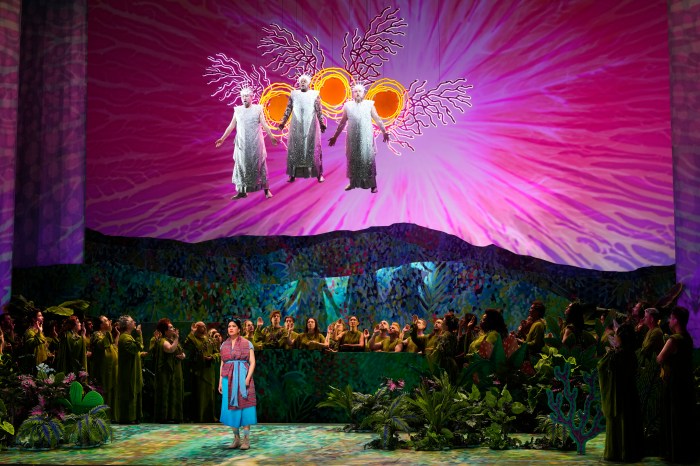After nearly 30 years of scavenging for a sound as resonant as “Ziggy Stardust,” “Hunky Dory” or even “Low,” David Bowie appears to have rediscovered his willingness to strip his music to its essence and rebuild it in a new way — first with 2013’s “The Next Day,” then the new “Blackstar,” which dropped on Jan. 8. Although the stretched-out movie-score style of the 10-minute “Blackstar” single isn’t as much of a leap as Bowie’s move from, say, his pinched rock-star singing on “Diamond Dogs” to the cool soul man on “Station to Station,” he’s far more present than he was in the ’90s or the ’00s. From his cutting-edge early experiments to his MTV cash-outs to his late-career malaise, here’s a ranking of Bowie’s studio albums (not counting live releases, soundtracks or singles) from best to worst.
1. HUNKY DORY (1971) As a plain old singer-songwriter — an especially honest and endearing one — Bowie pays tribute to Bob Dylan and Andy Warhol in fast little folk songs, rocks out in “Queen Bitch” and continues his sci-fi exploration with “Life On Mars?” And he opens with the immortal “Changes,” whose line “And these children that you spit on / As they try to change their worlds / Are immune to your consultations / They’re quite aware of what they’re going through” would open “The Breakfast Club” years later.
2. THE RISE AND FALL OF ZIGGY STARDUST AND THE SPIDERS FROM MARS (1972) Bowie’s partnership with lead guitarist Mick Ronson solidifies into one of rock’s greatest albums. The exhilarating “Suffragette City” introduces “wham, bam, thank you, ma’am!” to FM radio forever, but “Moonage Daydream” and “Hang On to Yourself” are almost as speedy and dense, and “Five Years” and “Rock ’n’ Roll Suicide” are poignant bookends.
3. LODGER (1979) If fans’ attention drifted during the second halves of “Low” and “Heroes,” Bowie and returning collaborator Brian Eno (he’s in charge of “ambience”) pointedly wake them up. Adrian Belew’s electric guitar has an alarm-clock quality that matches the structured urgency of herky-jerky rock songs like “Red Sails” and “D.J.”
4. ALADDIN SANE (1973) A less-focused Ziggy aftershock, starring the guy with the rainbow lightning tattoo on his face, “Aladdin Sane” is just as fast and rich and contains classics “Panic in Detroit” and “The Jean Genie” and memorable Ronson power chords.
5. STATION TO STATION (1976) Bowie experimented with a deep soul-man voice on “Space Oddity” and “Fame,” but he didn’t commit to it until this six-song gem of a transitional album. It opens with what sounds like a computer operating a table saw, then solidifies into a 10-minute funk groove that clearly inspired Talking Heads. “Golden Years” is nostalgic, but the Robot Professor Longhair quality of “TVC 15” is something new.
6. SCARY MONSTERS (1980) Even the lesser songs on this post-“Lodger” classic, like “Up the Hill Backwards” and the screeching, beeping title track, benefit from Bowie’s combination of detachment and rock and roll energy, and the slow-burning “Ashes to Ashes” is one of his most underrated songs ever. Pete Townshend and (especially) Robert Fripp contribute fierce guitars, and pianist Roy Bittan of Bruce Springsteen’s E Street Band takes a break from “The River” sessions to help out.
7. LET’S DANCE (1983) With the help of funk-and-disco pioneer Nile Rodgers of Chic, Bowie frequently succeeds in his attempt to take over the pop charts, inventing superb grooves on hits “Modern Love,” “Let’s Dance” and the sexy, mysterious “China Girl.”
8 (tie). LOW and HEROES (both 1977) A year after the greatest-hits album “Changesonebowie” streamlined his shaggy, up-and-down career for rock radio, “Low” and follow-up “Heroes” clear the palette. The first halves sound vaguely familiar — check out the tense rock song “Breaking Glass” from “Low” and the “Heroes” title track that would become an enduring anthem. But Roxy Music’s house scientist Eno takes over on both albums’ second halves, making ambient-electronic music for films and airports before he’d do so on his solo releases. The Eno of “Low” is especially dark and scary.
10. PINUPS (1973) Buying time for his next move (which turned out to be “Diamond Dogs”), Bowie covers Pink Floyd’s “See Emily Play,” The Who’s “I Can’t Explain” and “Anyway, Anyhow, Anywhere,” the Kinks’ “Where Have All the Good Times Gone” and the Easybeats’ “Friday on My Mind,” shifting their identities from acid-rock ’60s to glam-rock ’70s.
11. DIAMOND DOGS (1974) Any album that contains “1984” and especially “Rebel Rebel” can’t be all bad, but amid Bowie’s ’70s creative explosion, it’s surprisingly flat as a whole.
12. YOUNG AMERICANS (1975) Mostly notable for “Fame” and the title track, “Young Americans” serves as the not-quite-there precursor to the superior “Station to Station.”
13. THE NEXT DAY (2013) Returning to the cold but soulful voice of “Station to Station,” Bowie hasn’t sounded so present on his albums since 1983’s “Let’s Dance.” When he sings “If you can see me, I can see you!” he matches the urgency of his crack rock band.
14. THE MAN WHO SOLD THE WORLD (1970) After two mushy British-crooner albums, Bowie hooked up with Ronson in the personnel move of his life. Too many of these shaggy songs sound like contemporaries of Black Sabbath, but you can hear Ronson’s chemistry with Bowie evolving into something significant — particularly on the title track, whose killer guitar riff would inspire a crucial Nirvana performance decades later.
15. EARTHLING (1997) Borrowing the skittering jungle and drum-and-bass sounds of then-cutting-edge electronica acts such as Prodigy and Spring Heel Jack, Bowie and band make sounds so exciting that it’s almost possible not to notice the uninspired songwriting.
16. OUTSIDE (1995)
17. SPACE ODDITY (1969)
18. REALITY (2003)
19. HOURS (1999)
20. HEATHEN (2002)
21. BLACK TIE WHITE NOISE (1993)
22. NEVER LET ME DOWN (1987)
23. TONIGHT (1984)
24. DAVID BOWIE (1967)

















